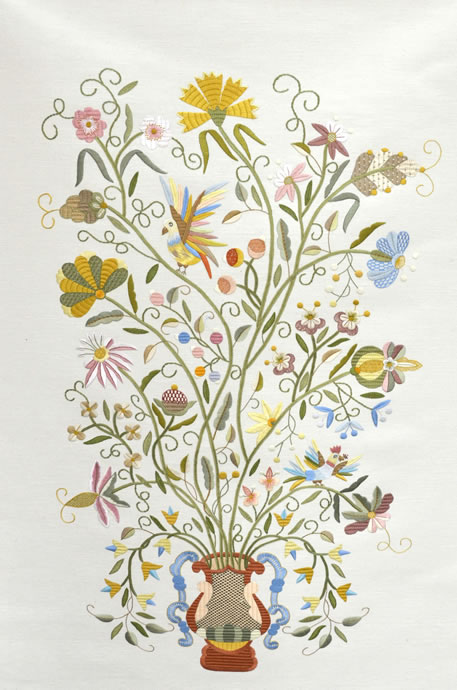PHYSICAL CHARACTERISTICS

Color
It is not easy to define the chromatic palette of the Castelo Branco Embroidery.
In fact, the colors visible today on the old pieces have already undergone a fading and alteration process that changes them, sometimes significantly. A study is underway on pigments that color the threads with which a set of historical quilts selected for this purpose were embroidered, the results of which may help redefine the original chromatic palette of this Embroidery.
In fact, in the operation to re-launch the production of the Castelo Branco embroidery, which took place from 1939 on, this care and attention were not taken into account, and so colors quite different from the originals have been used. In addition, during the 50's and 60's of the last century, which correspond to the great production of Elísio José de Sousa's workshop, there was a certain adaptation of the production to the colors that were then fashionable in interior decoration, which, for this reason, came to dominate the chromaticism of Castelo Branco's Embroidery.
Added to all this is the fact that the supply of silk thread has not been easy, so that often, when there was a shortage of silk thread, embroidery was (and is) done with thread that the market offered and not with those that would be more appropriate, a situation that is still sometimes the case today.
From what we can tell, in the absence of results from the above-mentioned study, we strongly recommend the reintroduction of more metallic and vibrant colors, such as:
Windsor Green, Bladder Green, and Toad Green;
Yellow Gold;
Ochre Gold, Ochre Copper;
Iridescent White (metallic hue);
Cerulean Blue, Cobalt Blue;
Crimson, Violet, Garança Brown, Garança Rose.
Embroidery Stitches
In the workshop production of Castelo Branco embroidery, the use of the Castelo Branco stitch, also known as "broad stitch", "loose embroidery" or "stitch thrown with prisons", is predominant.
It should be mentioned how the prisons that are part of the Castelo Branco Point, should be executed. In fact, since this is a stitch that largely dominates embroidery and gives it its very specific identity, it is necessary to be careful how it is executed, especially because there was a time when, as a rule, these arrests were always made parallel to the directions of the weft or warp threads of the fabric, giving the embroidery a rigidity and geometricism that compromised its gracefulness.
Thus, it is recommended that arrests always be made with the orientation of the motif design in mind, and not the structure of the fabric.
It is also recommended that when embroidering the White Castle Stitch, you do not use too much thread. The wires should never overlap.
Traditionally other embroidery stitches are associated with the Bordado de Castelo Branco, but, after the campaign of re-launching that took place from 1939 on, this panoply widened, integrating many more. The fact that the very rich quilts from the Lisbon Workshop were then considered as models led to that extension, and the embroidery stitches featured on them were used on the new Castelo Branco quilts.

